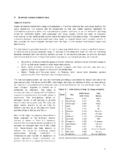Transcription of DEBT AND MACROECONOMIC STABILITY - OECD.org
1 Please cite this paper as: OECD (2012), debt and MACROECONOMIC STABILITY , OECD Economics Department Policy Notes, No. 16 January 2013. ECONOMICS DEPARTMENT POLICY NOTE No. 16. debt AND. MACROECONOMIC . STABILITY . Economics Department debt AND MACROECONOMIC STABILITY . Main findings Public and private debt levels are very high by historical standards. OECD-wide total financial liabilities now exceed 1 000% of GDP. High debt levels can create vulnerabilities, which amplify and transmit MACROECONOMIC and asset price shocks. High debt levels hinder the ability of households and enterprises to smooth consumption and investment and of governments to cushion adverse shocks.
2 When private sector debt levels, particularly for households, rise above trend the likelihood of a sharp economic downturn increases. Measures of financial leverage give less warning of an impending recession and typically only deteriorate once the economy begins to slow and asset prices are falling. During a recession debt typically migrates from the private sector to the government sector. Targeted macro-prudential policies would help in addressing future run-ups in debt . Robust micro prudential regulation and maintaining public debt at prudent levels can help economies cope with adverse shocks.
3 Legal frameworks can facilitate debt write-downs, but this may come at the price of a higher cost of capital. debt has risen to high levels debt as a share of GDP has surged in the OECD since the mid-1990s. Average total economy financial liabilities have gone beyond 1 000% of GDP during the recent crisis (Figure 1). The degree of total economy indebtedness differs strongly across countries, largely reflecting the relative importance of the financial sector (Figure 2). The size of the financial sector varies considerably, being markedly higher in countries, which host financial centres.
4 It also reflects differences in structure (for example, whether pension funds and insurance companies are well developed). Indebtedness of the other sectors also shows considerable cross-country heterogeneity. In the case of the household sector, some of the heterogeneity reflects differences in the importance of pension saving, which boosts household assets. In countries such as the Netherlands, high pension saving is accompanied by households borrowing more in order to purchase housing. 1. Figure 1. Financial liabilities have risen Total OECD area financial liabilities, non-consolidated debt , per cent of GDP.
5 % of GDP. 1600 1600. Non-financial corporate Government Households Financial 1400 1400. 1200 1200. 1000 1000. 800 800. 600 600. 400 400. 200 200. 0 0. 1970 1975 1980 1985 1990 1995 2000 2005 2010. Source: OECD, National Accounts. Figure 2. debt as a share of GDP varies across countries and sectors Gross financial liabilities (less financial derivatives and shares), non-consolidated, per cent of GDP, 2010. % of GDP % of GDP. 350 350 1 750 1 750. Non-financial corporte sector Financial sector Luxembourg 3780. 300 300 1 550. 1 500. 1 350. 250 250 1 250.
6 1 150 Different scale 200 200 1 000. 950. 150 150 750 750. 550. 100 100 500. 350. 50 50 250. 150. 0 0 - 50 0. ISR. ITA. FIN. DEU. DNK. GRC. AUS. SVK. CAN. CZE. USA. NLD. SVN. FRA. JPN. HUN. IRL. POL. GBR. AUT. CHL. KOR. NOR. EST. BEL. ESP. PRT. LUX. SWE. TUR. ISR. FIN. ITA. SVK. CZE. EST. HUN. SVN. CHL. FRA. LUX. POL. NOR. GRC. AUS. USA. CAN. AUT. ESP. DEU. PRT. SWE. KOR. BEL. JPN. DNK. NLD. IRL. GBR. % of GDP % of GDP. 350 350. 350 350. Government sector Household sector 300 300 300 300. 250 250 250 250. 200 200 200 200. 150 150 150 150. 100 100 100 100.
7 50 50 50 50. 0 0 0 0. ISR. ITA. FIN. CZE. CHL. SVN. HUN. SVK. LUX. BEL. AUT. DEU. FRA. EST. JPN. ESP. CAN. USA. AUS. CHE. IRL. NLD. DNK. POL. GRC. SWE. KOR. NOR. PRT. GBR. FIN. ISR. IRL. ISL. ITA. EST. CHL. LUX. CZE. NLD. AUS. KOR. SVK. SVN. AUT. FRA. SWE. NOR. DNK. POL. ESP. GBR. CAN. DEU. HUN. PRT. JPN. USA. BEL. GRC. Source: OECD, National Accounts. 2. High debt levels create a number of vulnerabilities debt can affect MACROECONOMIC performance through several channels. In some cases debt may directly transmit or amplify shocks, in other cases it may undermine the capacity to damp shocks.
8 For example, relatively high debt levels may increase the sensitivity of households or firms to changes in MACROECONOMIC conditions which can induce adjustments in borrowing, consumption and investment behaviour. Indeed, the empirical evidence suggests that when household debt is rising and reaches high levels consumption becomes more volatile (Figure 3). Figure 3. Real consumption volatility rises when household debt is rising Non-consolidated debt Change in household debt to disposable income 1. Change in debt to GDP ratio 0. 0. 0 0 Subsequent real consumption volatility Subsequent real consumption volatility Note: Consumption volatility is the average of the standard deviation of quarterly real consumption growth over the subsequent 5 years.
9 The figures show non-overlapping five-year periods. Source: OECD, National Accounts, OECD Economic Outlook 91 database. High indebtedness can create vulnerabilities, exposing households, firms and governments to mismatches, such as having loans due for repayment in the short-term but assets that mature later, as well as creating potential solvency problems. Furthermore, high indebtedness can make the economy vulnerable to asset price movements, which can amplify shocks and MACROECONOMIC instability. Shocks can be amplified, particularly when asset price boom-bust cycles act through the value of collateral and associated margin calls, which accentuate cyclical fluctuations and generate debt -deflation pressures.
10 Borrowers using assets as collateral are limited in their ability to borrow if the market value of collateral declines, which can thereby induce deleveraging. As experienced in the financial crisis, a shock to the apparently small sub-prime market was transformed into a full-blown crisis in large part due to balance sheet vulnerabilities. High debt levels in the financial sector create additional vulnerabilities, which can reverberate throughout an economy. When bank funding relies less on bank deposits, the greater role for securities markets creates a new set of vulnerabilities arising from abrupt changes in liquidity and corresponding difficulties of valuation.










![export incentives mys[3] - ACCA Global](/cache/preview/d/2/2/4/c/e/e/8/thumb-d224cee8bb516ab62c83b3714ae65fbf.jpg)





